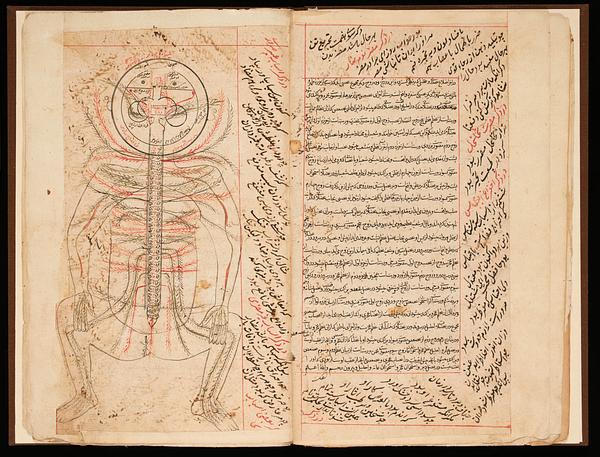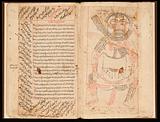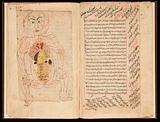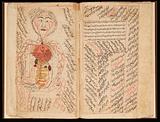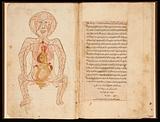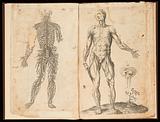A copy of Mansur ibn Ilyas’s Tashrih-i mansuri (25 hand-written + 10 printed leaves). First shown leaf: Fol. 11r, Man seen from behind
Iran; Rajab 1048 H = November/December 1638
Each leaf c. H: 30; W: 18.8 cm
The text for “Mansur’s Anatomy” was originally written by the Persian doctor Mansur ibn Muhammad ibn Ahmad ibn Yusuf ibn Ilyas in 1396. It is the first anatomical work in the Islamic world to depict man as a whole rather than individual parts, and it is based by and large on the work of the Greek physician Galen.
Mansur’s writings, the oldest existing examples of which date to 1412, were copied right into the 19th century. The illustrations, of which the one that shows the skeleton is missing here, have largely remained unchanged throughout the ages. They are highly schematic and could best be described as explanatory diagrams.
The fact that Persian physicians were interested in the Europeans’ more naturalistic renditions of the human body is documented by 10 pages from the anatomic Toutes Les Oeuvres De Me André Du Laurens, published in Paris in 1621. They were included in the manuscript and according to the Persian inscription were a gift to Shah Sulayman from a European ambassador in 1680. The Shah is said to have had the text translated.
Fol. 16r, Man’s organs and veins
Fol. 18r Man’s organs and arteries
Fol. 25r, A woman’s organs with womb and an embryo
Fol. 34v, “La Deuxieme Table Des Muscles” from Laurens
Inv. no. 17/2016
Published in:
fol. 18r - Kjeld von Folsach, Joachim Meyer: The Human Figure in Islamic Art – Holy Men, Princes, and Commoners, The David Collection, Copenhagen 2017, cat.no. 20;
